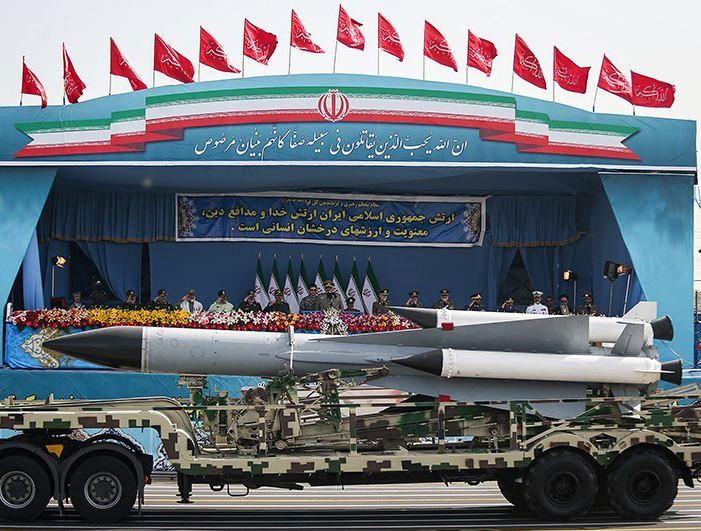Iran last week unveiled a handful of new missile systems and advanced war drones amid escalating threats to attack Israel if the Jewish state makes "even a small mistake" in the region, according to reports in Iran's state-controlled press.
The country unveiled the missile systems during military parades held last week celebrating Iran's National Army Day. The hardline regime's air force, ground force, navy, and air defense forces all displayed new domestically produced weaponry designed to deter and intimidate Israel from launching operations on Tehran's contested nuclear program, which has expanded in the years since President Joe Biden began diplomacy aimed at securing a revamped version of the 2015 nuclear deal.
The military event featured a line of armed drones, including an advanced "suicide drone" that Iranian military leaders said is produced to counter Israel's Harop drones, which can target enemies on the ground and self-destruct. The new drone "could be flown from both ground and offshore launchers," according to Iranian officials quoted in the state-run Tasnim News Agency.
Iran revealed the new military equipment on the same day its president, Ebrahim Raisi, issued threats to attack Israel. The warnings come as Israel considers its options in response to Iran's escalating nuclear program. Israel is believed to have launched several covert operations to sabotage Tehran's program during the past several years and could strike the country's nuclear infrastructure, especially if Iran's program reaches advanced stages of development on an atomic weapon.
"Not a small movement of the enemy is hidden before the sharp eyes of the Iranian Armed Forces," Raisi said, referring to Israel. "If they make the smallest mistake, our response will be given at the center of the Zionist regime and our Armed Forces won't let them relax."
Raisi's comments were directed toward the "Zionist regime" and meant to signal that "Iran's security forces are monitoring all of its activities."
In addition to the new suicide drones, Iran displayed what it called a "new generation of Ababil drones," a long-range surveillance drone used for targeting. The Ababils were billed as a "major achievement" and displayed on trucks during the military parade.
Iran says the new drones are equipped with an assortment of air-to-ground and surface-to-air missiles, all of which it could use in a potential standoff with Israel.
Three new missile systems also were announced during the event.
The Fath 360 system is a ground-to-ground missile system that fires long-range artillery rockets and also could be used for strikes on Israel and other neighboring countries. A second system is reportedly constructed to perform radar operations and missile launches simultaneously. The third system, called Dezful, is an air defense system modeled off Russia's Tor missile system, which fires short-range surface-to-air munitions.
"Iranian military experts and technicians have in recent years made great headways in manufacturing a broad range of indigenous equipment, making the armed forces self-sufficient in the arms sphere," Tasmin reported.
Iran also announced in recent days that it is expanding Islamic Revolutionary Guards Corps (IRGC) operations in international waters. The IRGC's navy division is drafting plans to expand its forces' "operational depth" in "faraway waters." The announcement comes as Iran seeks to increase its presence in South America and other areas close to the United States. This includes a January operation in which an Iranian tanker delivered oil to Venezuela, in violation of U.S. sanctions.
Behnam Ben-Taleblu, an Iran expert at the Foundation for Defense of Democracies think tank, said Iran's increasingly sophisticated arsenal of drones "should be of particular interest for policymakers in the U.S. and security planners in the region."
"Drones are increasingly being used, along with missiles and rockets, in Middle Eastern conflict zones where the Islamic Republic has a partner or proxy in the field," Taleblu said. "Not only are sanctioned Iranian defense contractors and the regime's military-industrial complex engaged in drone production, but Iran is supporting the capabilities of its proxies through part proliferation, transfers, and aiding local production."
The production of this equipment is likely to embolden Iran and create a "lower bar for [the weapons'] use and greater Iranian sense of confidence that they can manage regional escalation dynamics," according to Taleblu. "Drones are an increasingly lethal element of Iran's 'long arm' that can strike or harass enemy targets and positions in the region."
